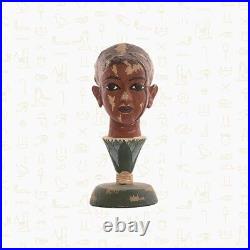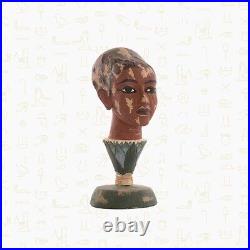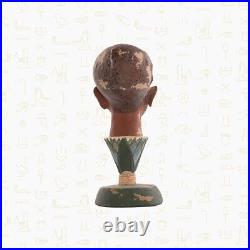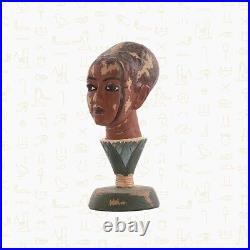Rare Antique Ancient Egyptian Tutankhamun Emerging From Lotus Flower Museum Rep





Rare Antique Ancient Egyptian Tutankhamun Emerging From Lotus Flower Museum Replica with Authenticity Certificate. Embark on a journey through ancient Egypt with this Rare Antique Ancient Egyptian Tutankhamun Emerging From Lotus Flower statue.
Authenticated with an official certificate, this captivating piece symbolizes rebirth and divinity, encapsulating the essence of Egyptian mythology. Crafted with intricate detail, it serves as a stunning testament to the craftsmanship of ancient artisans. Add a touch of historical elegance to your collection or home decor with this mesmerizing artifact.
Don't miss your chance to own a piece of ancient Egyptian history. King Tutankhamen-or King Tut as he is more commonly known today-was relatively unknown to the world until 1922, when his tomb was discovered by Howard Carter. His tomb contained thousands of artifacts, a sarcophagus containing his mummy, and a now-famous headdress. It took Carter and his team almost ten years to catalog the contents of the tomb.Since the tomb's discovery, King Tut has become the world's most well-known Egyptian pharaoh, fascinating generations of scientists and students. Tutankhamen was born around 1341 B. His name means living image of Aten. Aten was the name of the sun deity Tutankhamen's father and predecessor to power, Akhenaten, ordered his people to worship.
Before this decree, ancient Egypt had been a polytheistic society, meaning that it worshipped many gods instead of one. Akhenaten also moved the capital and religious center of Egypt from Thebes to Amarna. When Akhenaten died, Tutankhamen took his place. He was just nine years old.
Aided by advisers, King Tut reversed many of his father's decisions. This "boy king" ruled for less than a decade; he died at age nineteen. For many years, people puzzled over King Tut's death. Others speculated his death was an accident. However, almost a century after his tomb was discovered in the Valley of the Kings, scientists used digital imaging and DNA testing to suggest King Tut most likely died from malaria or an infection. Modern technology has also shed light on other mysteries surrounding Tutankhamen. For years, people speculated King Tut's tomb might have hidden chambers holding the remains of the Nefertiti, a famous Egyptian queen and wife of Akhenaten. This theory was dispelled when radar testing revealed no hidden chambers in King Tut's tomb. Compared to many other burial tombs, King Tut's final resting place is small and unassuming. Yet, it remained untouched for thousands of years.The nearly five thousand artifacts and well-preserved mummies found in the tomb have brought new insights into life in ancient Egypt and the governance of the boy who became king. The ankh or key of life is an ancient Egyptian hieroglyphic symbol used in Egyptian art and writing to represent the word for "life" and, by extension, as a symbol of life itself. By extension of the concept of "life", the ankh could signify air or water. In artwork, gods hold the ankh up to the nose of the king: offering him the breath of life. The ankh may have been used decoratively more than any other hieroglyphic sign.
Mirrors, mirror cases, and floral bouquets were made in its shape, given that the sign was used in writing the name of each of these objects. Some other objects, such as libation vessels and sistra, were also shaped like the sign. This piece would be a precious gift for your loved ones, as it was crafted by Egyptian hands to be an authentic replica of the original artifact piece, and it comes with an authorized/documented certificate from the Egyptian Supreme Council of Antiquities to ensure its quality and authenticity. Contains: Key of Life earrings, Key of Life necklace, Key of Life medal, and a Key of Life Replica.
Please Review Our Other Products For Sale For More Good Deals. If You Are Happy With The Product After Receiving It In A Good Stand Please Share Your Feedback.
